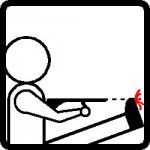20 Nov 2011
Are You Linkedin When You Should Be Linkedout?
Do you have a profile on Linkedin? If you do, this information is vital to your privacy and the sanctity of your ever-precious Inbox.
If you’re a professional or business owner, chances are you use a mix of social media tools (such as Facebook, Twitter, Linkedin and Google+) to build your brand and your circle of influence. And if you are like me, you have had to learn quickly how to manage your account settings on each one to minimize the amount of spam and unsolicited offers you receive.
Linkedin has recently made some changes which allow your names and photos to be used for third party advertising. The default setting on this function grants your permission, even though you have never specifically been contacted or asked. What this means is that you will now begin to send and receive alerts and promotions that appear to be endorsed by you or people you trust. It all looks legitimate, except none of you have granted your permission.
Thankfully, this is easy to fix.
Here Are 4 Simple Steps to Change Your Default Permission Setting on Linkedin
1. Click on your name on your Linkedin homepage (upper right corner of your profit). On the drop-down menu, select “Settings”.
2. From the “Settings” page, select “Account*”.
3. In the column next to “Account”, click “Manage Social Advertising” .
4. Un-tick the box next to “Linkedin may use my name, photo in social advertising” .
One of the things that I like most about Linkedin is that I receive a lot less spam, MLM offers and unwanted messages than on other social media services. If you are like me, you’ll want to take steps to keep it that way.
Also, if you are concerned with that amount of email that you have been getting lately from Linkedin, you may also want to check the new default settings under E-mail Preferences and Groups, Companies & Applications (such as Data Sharing with 3rd-party applications). All of this can be managed simply by you in your “Settings” tab.
This way YOU can decided whether you want to be Linkedin or Linkedout to unsolicited third party offers.
When clients ask how to close more sales and free up cash in their business, I like to tell the story of Byron the guns and collectibles dealer. He lives for his business because it gives him the chance to make a living out of doing what he enjoys most: collecting.
He was struggling 12 months ago because he was out of cash and unable to buy new stock. This was a real problem because the strength of his business lay in constantly having new items to show off. New stock encouraged his customers to come back often; no new stock meant they would tend to check out his competitors first.
When I first walked into Byron’s shop, one of the most obvious items was a beautiful old gun, proudly (and securely) displayed in a glass cabinet. I couldn’t help but ask how much it was worth. He explained that it he had bought it for $5,000 dollars, but was looking to sell it for $7,000. Following a hunch that I had hit on his problem straight away, I asked Byron when he had bought the gun. He didn’t remember exactly, he said, but thought it was about five years ago.
I asked Byron how many other, similarly high value items he had in his store. We went for a walk and in the course of showing me around, he pointed out at least a dozen items which he had bought for over $5,000 over the last few years. In each case, he was quick to tell me how much he was intending to sell the item for, and the margin was always 30 to 40%. But the fact was he hadn’t sold these items so they were costing him money and, most importantly, causing him to miss the opportunity of buying new stock.
Byron had spent nearly $100,000 on expensive items over the years. The items were attractive and valuable, but they weren’t particularly rare, so they weren’t appreciating in value significantly. In effect, Byron had put $100,000 on the shelf of his office and left it there for all that time. In other words, while he wasn’t borrowing money from the bank, in effect he was borrowing it from himself. He had missed the opportunity to invest the money somewhere where it would give him a solid return, such as in a term deposit or in blue-chip shares. And he missed the opportunity of using that money to buy smaller, less expensive items that he knew would sell quickly. He needed to do something (and fast) if he wanted to close more sales.
Compounding all of this was the fact that the global financial crisis had caused demand to drop markedly which meant his customers just weren’t coming in or spending as much as they used to.
By making a few simple adjustments, responding to trends in the industry and addressing a need that his customers, Byron was able to turn his business around, close more sales and double his bottom line.
The first thing he did was to free up some cash by actively selling some of his more expensive and slow moving items. He used online auction sites and his own network to find buyers, while keeping his marketing costs low. In some cases he had to sell the items for a little less than he had intended, but the benefit (when he was able to close more sales) was cash in his pocket.
The next thing he did was set up some systems to keep better track of inventory. He started by recording everything and noting the age of all the items (i.e. the length of time he had held it in stock). We agreed that in future, any item that had not sold after 8 months would be reviewed. Byron would investigate the item’s market value and decide whether or not it was increasing in value sufficiently to be worth keeping. If not, he would act to move the item on.
After a few months, Byron was making much smarter purchasing decisions. He was still enjoying ‘collecting’ for his store, but his focus was different. His focus was less on attractive, expensive but not-so-rare items, and more on smaller items he knew he could sell quite quickly. To his pleasant surprise, he increased cash flow by $100,000 in 3 months and found that by using this strategy, he was able to do more shopping rather than less, because he had more cash available to spend.
Lastly, but perhaps most significantly, Byron introduced 2 new complementary strategies which literally transformed his business. To counteract the soft demand for firearms and the relatively fixed, low margins, Byron convinced his customers to purchase 18 months worth of ammunition upfront and he provided storage (if required) onsite. This allowed him to renegotiate terms and pricing with his suppliers, plus generate more cash flow in the short term. Since the margins on bullets was much higher than on the guns themselves, his overall profitability improved. In addition, Byron incorporated training and certification into his standard offering and opened up his target range to paying customers 3 nights a week. This allowed him to create new, highly lucrative income streams and increase the frequency with which his customers came into his business.
While Byron’s story on how to close more sales might seem unique and industry specific, there are many ways to take the overarching philosophy of what he did and utilize it to improve your operating cash position.
How can you identify and start selling silver bullets in your business? Begin by first examining the big picture…
Identify the items in your inventory that are essentially dead stock – i.e. haven’t sold in over 8 months. Determine what the total value of the stock is and devise a plan to convert it quickly into cash using a minimal amount of advertising.
Focus on the gross profit margin of all of your products and services. Are some of these more profitable than others? To improve your overall performance, concentrate on the former, and improve or eliminate the latter. What items or services could you add which would allow you to service a need, improve your relationship with your customers and grow your bottom line?
Negotiate better terms and/or prices with your supplier in order to increase the amount of gross profit you make on each sale. Consider which items you could sell in bulk upfront to your customers and use this new volume to improve your buying leverage or cut out the middle man.
Marketing should not be treated as a fixed and sacred cow in your business. Do not spend another dime on marketing until you ensure that you are maximizing the amount you retain on each sale to cover fixed costs. Also, only spend money chasing customers and sales if you can measure the financial return that you will get. Unless you are a multinational brand, money spent solely on branding is wasted.
Make it easy for your customers to find you and see what you have to offer on the internet. The database of potential shoppers that you have earned the right to speak to, is in fact your greatest asset. What can you do today to add value, enhance their experience and close more sales?
Finally, examine the fixed expenses in your business. Identify whether or not there is a cheaper, faster or superior alternative that doesn’t compromise quality or customer service. Is there a way to shift how and what you do so that fixed expenses can vary (i.e on a pay per use basis) with the level of production and/or sales? And remember, no one has ever grown their business by [exclusively] focusing on cost cutting – so use this tactic as your final step in a comprehensive plan to get your business firing and hitting targets. Your primary goal is to close more sales and increase the amount of gross profit (or contribution margin) that you make from each sale.
 There’s nothing like a good reality TV train wreck. We all know that we are not supposed to look. It’s not politically correct to indulge in the shortcomings or misfortune of others. But we just can’t help ourselves, can we? The show is SO bad, it’s almost addictive.
There’s nothing like a good reality TV train wreck. We all know that we are not supposed to look. It’s not politically correct to indulge in the shortcomings or misfortune of others. But we just can’t help ourselves, can we? The show is SO bad, it’s almost addictive.
The Celebrity Apprentice is a reality-show-train-wreck like no other. Where else can you find a group of 12 wanna-be-celebrities who don’t have an ounce of talent, business acumen, common sense or humility between them? I mean seriously, where did Channel 9 get these people? They are touted as 12 of Australia’s most well know personalities. If that is true, God help us all.
The premise is admirable – the celebrities have been asked to bring their time, creativity and rolodexes to raise money for their favorite charity. Someone must have forgot to brief Deni Hines on these basic requirements because she refused to sing in one of the challenges (which is something she is supposedly famous for) because “she needed to protect her brand as a singer, animal activist and vegetarian.” Is she serious? Deni may want to re-think that strategy because she did more damage to her own brand in 2 weeks on the show than Allan Joyce did by grounding the entire Qantas fleet.
The only redeeming feature on the show is the ever charming, Mark Bouris. He comes across as engaging, fair and straight down the line. However, the show seems more like a glorified 60 minute advertisement for his company, Yellow Brick Road, than a charity fundraiser or bona fide reality series.
Channel 9, surely you jest?
Either your producers have completely run out of clever and entertaining ideas or you’ve grossly underestimated the IQ of the average Australian. We all expect reality TV to be staged, sensational and surreal. The Block, Australian Idol and Masterchef fit this bill perfectly. However, Celebrity Apprentice is just plain stupid. The formula is uninspired, the talent is questionable and the show simply has no point.
Seriously mate, were not in Kansas anymore! These 12 contestants have as much chance capturing the hearts and attention of the Australian public as you and I have of meeting the Wizard of Oz on the Yellow Brick Road.
09 Nov 2011
8 Ways You Sabotage Your Own Success in Business
As a business owner, I’ll bet you’re incredibly busy and find that there never seems to be enough hours in the day to complete all your work.
Have you ever noticed that some of your everyday activities are just deeply ingrained habits – driving your car, putting on your watch, brushing your teeth or taking a shower? You wouldn’t dream of not doing them, they are part of your routine and they just seem to happen automatically. In your business you also have habits such as checking your website, opening the mail, reading emails, grabbing a coffee and glancing at your diary. You do them without conscious “thought” and they seem to fill up hours in your day…
But what about all the actions you need to take in order to build a more profitable and efficient business? Like following up with your best customers, asking for referrals, strategic planning and goal setting to grow your business? When do you do these activities? Do they often get relegated to “tomorrow” or “sometime soon”?
If you’ve ever spent your day stuck in back to back meetings, answering routine questions from your team, responding to emails, helping other people, doing paperwork or tidying your office – you already know that these are “make busy” activities, and they will keep you trapped where you already are – just simply maintaining, not growing your business. By filling your days with these tasks, you are in effect avoiding the very activities that you know will really move your business forward and produce tangible results.
Your “make busy” work or habits create the magnificent illusion that you are hard at work, simply because you feel “flat out” and your day is full of tasks. Let’s be honest, you would actually rather do anything than face the activities you know would radically accelerate your business success NOW! In fact, you often get to the end of the day and say to yourself “It’s OK, I was really busy, I’ll just get to that marketing plan tomorrow.” Or “I just couldn’t find the time today to make that seminar on leadership or customer loyalty.”
If you are waiting for the right or best time to do these critical activities in your business, it will simply never come! There will always be other “busy work” to fill all of your available time. You need to find a way to make your business building activities an ingrained habit too, if you want to grow your bottom line and live the lifestyle of your dreams.
Do you relate to or identify with any of these common sabotage habits?
1. Perfectionism – this tactic is insidious. It often immobilizes us from making a decision, starting a project or activity and signing off on a piece of important work. Most tasks don’t have to be 100% perfect, they just need to be good enough. The other way that this can show up is when you deceive yourself into believing that no-one else can do the job (even simple routine tasks) to your exacting standard, so you must do it ALL yourself. Follow the 80/20 rule, delegate what you do not have to do yourself and give yourself permission to be human!
2. Refusing to Let Go of The Past – Have you ever heard yourself say “last time I tried that, it didn’t work”? Or have you ever simply avoided doing something that you know you should or need to do but were afraid to do because “last time it didn’t work out the way you wanted it to”? Even though it’s a good idea to stop doing what clearly doesn’t work, it’s important to remember that the past does not necessarily equal the future. If you catch yourself finding reasons from the past to justify why you are not moving ahead toward your compelling future, stop NOW and take a good hard look at whether these are just cleverly disguised forms of self-sabotage.
3. Lack of Accountability – who is holding you accountable to the decisions you make and the actions you take in your own company? Isn’t that why you went into business for yourself in the first place – so that you could be the boss and do things your way? Find someone outside your business – a coach, mentor or trusted advisor that can act as a sounding board and hold you accountable to staying on track.
4. Lack of vision, planning and specificity – if you don’t know where you are going, how will you know when you get there? Enough said. If you don’t have a 90 day, 1 year and 3 year business plan, you need to make this your number one priority in your business. Set a weekend aside and find a place where you will not be disturbed by anyone or anything. Set down your goals clearly and succinctly – get clear about the specifics (who, what, where, when and why) and set realistic deadlines for completion. Goals need to be written down in detail to allow your mind – which is a goal seeking mechanism – to do its magic.
5. Lack of focus – stay focused on the important task you are currently working on and only allow yourself to be diverted by real emergencies.
6. Fear of Financials – you cannot have a truly successful business if you don’t know your numbers. Not knowing your numbers has already cost you time and money. Find someone who can explain your financials to you in plain English – learn the key drivers and indexes in your business (such as break even, productivity ratios, inventory turns, gross profit margins etc.) and track them daily.
7. No USP – the greatest product or service in the world will not sell if you have not clearly defined why someone should buy from you instead of your competitors. “Build it and they will come is a fallacy.” If you have not yet figured out what is unique about your product or service and found a compelling and cost effective way to communicate it in everything you do, you are literally flushing your marketing budget down the toilette.
8. No Testing and Measuring – this is the most-often overlooked activity by small business owners. The simple act of testing and measuring everything in your business…and I mean everything…will save you thousands of dollars this year. No matter what “it” is, if you haven’t tested and measured “it”, you don’t really know if “it” works. And until you know if it works, you don’t have a reliable, predictable business that will run without out.
Unfortunately, there are no quick fixes. As you already know or suspect, some of the most common forms of self-sabotage are habits because they are deeply ingrained behaviours that take time to establish or eliminate. In the 1960’s a highly regarded plastic surgeon, Dr. Maxwell Maltz discovered that it took 21 days for amputees to cease feeling phantom sensations in their amputated limb. From further observations and significant research he established that it takes 21 days to create a new habit.
Brain circuits take engrams (which are essentially “memory traces”) and produce neuroconnections and neuropathways only if they are bombarded for 21 days in a row. This means that our brain does not accept new data or information for a change of habit unless it is repeated each day (without fail) for at least 21 days. Changing habits (whether positive or negative) can be done but it takes time and consistent effort.
Do yourself a favour and identify today which form of self-sabotage is the primary one that is holding you back from having the business and lifestyle of your dreams. Make a plan on paper – specific decisions and actions that you can take to move forward in this aspect every single day for the next month. It is imperative to track your progress each day and I highly recommend finding an objective person outside of your business to hold you accountable to your plan, actions and results.
31 Oct 2011
Looking for a Melbourne business coach?
Are you at a crossroads in your business? Perhaps you are working too hard and not achieving the financial results you deserve or maybe you are just looking for better and more effective ways to grow your business profitably?
Business coaching can assist you to achieve phenomenal improvements in your business – the crucial step is to find and select a Melbourne business coach that is ideally suited to inspire and empower you with the right questions, tools and strategies to move your business and your results forward. You need to find someone who “gets you” and your business and can help you to quickly identify where you need to focus your energy and resources to get the maximum impact on your bottom line. In order to work smarter, not harder, this means your coach will show you how to stop doing all the things that are hurting your results or holding you back.
Even though I started off as a Melbourne business coach, I have presented to over 15,000 business owners worldwide and coached businesses in almost every industry – including trades, retail, hospitality, professional services, building and construction, furniture and homewares, import/export, automotive, manufacturing, aged care and health services, medical and health services, agriculture, mining, pharmaceuticals, accommodation, warehousing, media, financial services, rental and hiring, employment and education. I have a proven track record as a Melbourne business coach (and with clients around the world), helping entrepreneurs just like you achieve their dreams and goals. I can help you:
- Increase the number of leads and sales you get for every dollar you invest in sales and marketing activities
- Grow your bottom line and cash flow reliably and predictably
- Break even sooner each month so that you can put more cash back in your own pocket instead of just paying everyone else
- Reduce the amount of time and money you waste on activities that are not productive in your business
- Understand the key drivers in your business so that you can set realistic targets and communicate them effectively to your team
- Demystify the numbers in your financial statements so that you don’t have to wait till the end of the financial year to find out whether you achieved your goals or not
- Ask better questions, make better decisions and step up as a leader
Do these sound like the sort of results that you’d like to achieve for your business? Great, then you may want to submit an application form now to be considered for one of my upcoming coaching programs. Please know that I am very selective in who I choose to work with and am looking for business owners who are:
- Committed to the goal of growing a strong business and are willing to do the work
- Willing to step back and evaluate what is working and not working
- Serious about tracking and measuring their results so that we can set targets and key performance indicators
- Interested in building and strengthening the team around them
- Keen to put systems in place so that the business operates more reliably and predictably
- Exploring an exit or succession strategy
So if you have decided to move forward and find a Melbourne business coach that can assist you to step up and boost your results, please drop us a line and let us know why you would make an ideal client.
As discussed above, there are a multitude of scenarios and reasons why you might seek out a Melbourne business coach, but one thing is for certain, it pays to do your due diligence and seek out a creditable business coach or mentor. Here are my top tips for finding a reputable Melbourne business coach that can help you:
- Research their credentials – look for someone who has committed to their own business and coaching education and who has a wealth of experience across disciplines (not just sales and marketing credentials).
- Beware of anyone who does not analyse your financial statements up front and assess the health of your business before commencing work with you on plans and strategies.
- Avoid social media and branding experts – many of these “experts” have little business experience and you can easily waste thousands of dollars and get no return on your investment.
- Read the publications and media coverage for your potential coach – the best candidates will have strong followings, lots of relevant media exposure and the ability to explain important concepts and strategies to you in plain English.
- Look for a Melbourne business coach that has built successful businesses in the past – avoid coaches whose testimonials are non-specific or cannot be validated.
- Insist on a coach that has at least 3 years experience coaching and has a client retention history of at least 12 months.
These questions are fairly straightforward but crucial for helping you decide on the right Melbourne Business Coach who is qualified and capable to assist you.
If you’d like to know more about how business coaching can help you to achieve your goals, please fill in the contact form on this page with your request.
Rhondalynn
Your Melbourne Business Coach.













